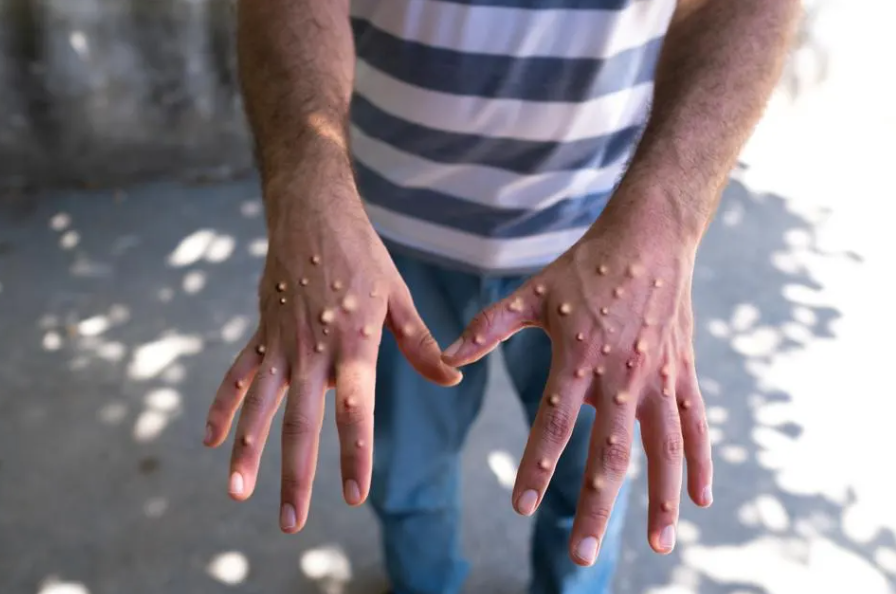The World Health Organization (WHO) has declared mpox, formerly known as monkeypox, a public health emergency of international concern as the Democratic Republic of Congo battles its worst outbreak to date. Since January 2023, over 27,000 cases and approximately 1,100 deaths have been reported, triggering global alarm due to the rapid spread of a new variant of the virus.
What is Mpox?
Mpox, formerly known as monkeypox, is a viral infection that causes a rash and flu-like symptoms. It’s part of the same family of viruses as smallpox but is generally less severe.
Symptoms of Mpox
Mpox symptoms typically appear within 3-21 days after exposure. They often occur in two stages:
-
Stage 1: Flu-like symptoms
- Fever
- Headache
- Muscle aches
- Backache
- Chills
- Fatigue
- Swollen lymph nodes
-
Stage 2: Rash
- Begins as flat lesions that become raised bumps filled with fluid
- Lesions can appear on the face, palms, soles of feet, and other parts of the body
- Lesions may be painful or itchy
Prevention of Mpox
- Avoid close contact: This includes direct contact with rash, bodily fluids, respiratory droplets, and contaminated items.
- Practice good hygiene: Wash hands frequently with soap and water.
- Safe sex practices: Reduce the number of sexual partners and use condoms.
- Vaccination: The mpox vaccine is available and recommended for high-risk individuals.
How is Mpox Transmitted?
Mpox can be transmitted from person to person through direct contact with infectious skin lesions or other lesions, such as those in the mouth or on the genitals. The virus can also spread through contaminated objects like clothing or linens, or in communal settings such as tattoo parlors. Given the potential for transmission in various environments, it is crucial to take preventive measures to control the spread of the disease.

Mpox: Current Situation
Africa, particularly Congo, has seen a dramatic rise in mpox cases. The Africa Centers for Disease Control and Prevention (Africa CDC) reported a staggering 160 percent increase in infections and a 19 percent rise in deaths compared to last year. The newly discovered variant of mpox in Congo is especially concerning due to its higher fatality rate and potential for easier transmission. Unlike previous outbreaks, this variant causes milder symptoms and lesions, primarily on the genitals, making it harder to detect and contain.
Mpox: A Viral Disease
Mpox is a viral disease that causes painful skin lesions, fever, headaches, and muscle aches. It is zoonotic, meaning it can be transmitted from animals to humans, but it also spreads between people through close contact, including physical touch with infectious lesions or contaminated objects like clothing or bedding. The infection typically lasts between two and four weeks, with symptoms that can be severe, especially in vulnerable populations.
Differences from the 2022 Outbreak
The current outbreak in Congo differs significantly from the 2022 global outbreak. In 2022, mpox primarily affected gay and bisexual men and was transmitted largely through close contact, including sexual activity. However, the present outbreak in Africa is taking a different toll. Over 70 percent of cases and 85 percent of deaths are occurring in children under 15 years old in Congo. WHO Director-General Tedros Adhanom Ghebreyesus has called for a “tailored and comprehensive response” to address the diverse transmission patterns and risks presented by this outbreak.
Treatments for Mpox
While there is no specific treatment for mpox, several strategies and supportive care measures can help manage the symptoms and reduce the severity of the disease. Here’s a breakdown of the current treatment options and supportive care:
1. Antiviral Medications
- Tecovirimat (TPOXX): This antiviral drug, originally developed to treat smallpox, has shown effectiveness against mpox. Tecovirimat works by inhibiting the virus’s ability to spread within the body, helping to reduce the severity of symptoms and the duration of the illness.
- Cidofovir and Brincidofovir: These antivirals have been used experimentally to treat severe cases of mpox. They work by inhibiting viral DNA replication, which can help control the spread of the virus within the body. These drugs are usually considered for patients with severe symptoms or those at high risk of complications.
2. Vaccination
- Smallpox Vaccine: The smallpox vaccine (e.g., JYNNEOS or ACAM2000) provides some protection against mpox due to the similarities between the two viruses. In some cases, vaccination after exposure to the virus can reduce the severity of the disease.
3. Supportive Care
- Symptom Management: Supportive care focuses on relieving symptoms such as fever, pain, and itching. Over-the-counter medications like acetaminophen or ibuprofen can help manage fever and muscle aches, while topical treatments may soothe skin lesions.
- Hydration and Nutrition: Ensuring adequate hydration and nutrition is essential, especially for patients with severe symptoms. In cases where the patient is unable to eat or drink, intravenous fluids and nutritional support may be necessary.
- Wound Care: Proper care of skin lesions is crucial to prevent secondary infections. This includes keeping lesions clean and covered to avoid further irritation or infection.
4. Isolation and Infection Control
- Isolation: Infected individuals should be isolated to prevent the spread of the virus to others. This includes avoiding close contact with others and practicing good hygiene.
- Infection Control Measures: Healthcare settings must implement strict infection control protocols, including the use of personal protective equipment (PPE) by healthcare workers, to prevent the spread of the virus.
Conclusion
While mpox can be serious, especially in vulnerable populations, the combination of antiviral treatments, vaccination, supportive care, and infection control measures provides an effective approach to managing the disease. Early detection and treatment are key to improving outcomes for those infected.



